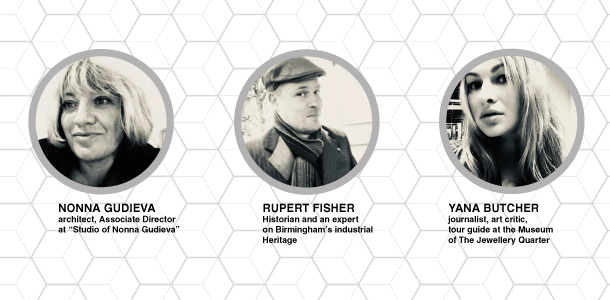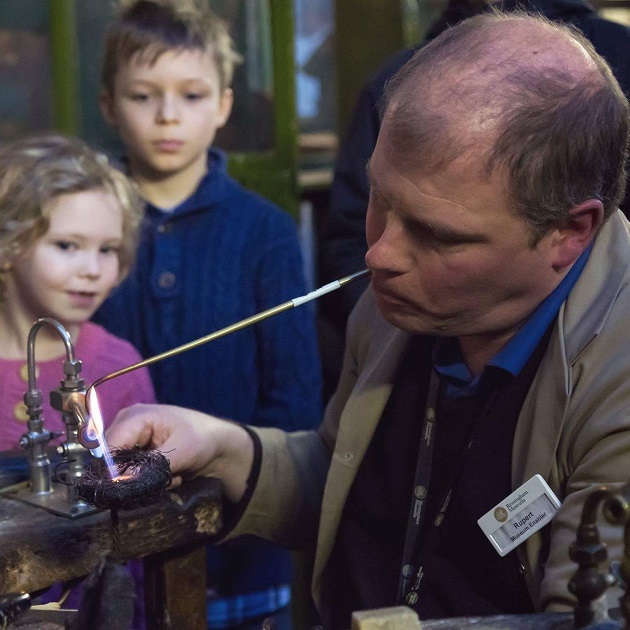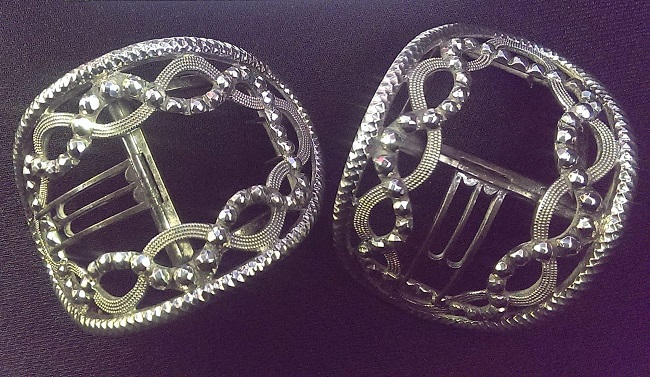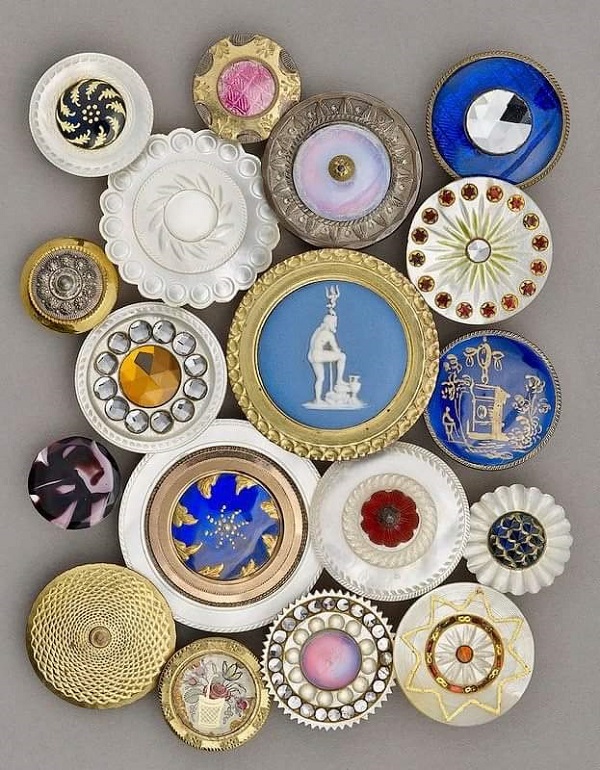Подписка на новости
Телеграмм
Jewellery Quarter treasure of the industrial Heritage
Nonna Gudieva, architect:
«The idea to create this interview came into life because of our conversation with Yana Butcher, an employee of the world-famous Birmingham jewellery museum -our acquaintance grew into a fascinating discussion of jewellery, and although I have been engaged in architecture for more than twenty years, the jewellery theme has captured me, because architecture and jewellery design grow from the same root, even if at first glance it seems that there is not much in common between decoration and an apartment house».
18.09.2018, 16:51 | Автор: Nonna Gudieva, Yana Butcher

photo: Nonna Gudieva, Yana Butcher
In addition, I was able to talk with the museum historian, Rupert Fisher, a man who knows everything about the museum and the jewellery Quarter of Birmingham.
Several years ago, while traveling in South America, in Rio de Janeiro, I visited the jewellery factory Hstern, Oscar Niemeyer used to work with this jewellery factory. It was the moment when my great love for jewellery design began, which has much in common with architecture.
There is a poetic definition of architecture by Joseph Brodsky:
"You are, in essence, something that nature failed to create"
These words can be turned to jewellery as well, as if the initial material of the jeweler-precious stones were not enchanting, they become metal with the work of jewellery art only when the harmony of the line and forms, created by the creative genius of man, joins the qualities of the material.
And this is the reason why jewellery brands are collaborating to work on the design of their products with some great architects-Tiffany & Co collaborates with Frank Gehry, Zaha Hadid, Ross Lovegrove. Ron Arad worked with Swarovski, the jewelry brand Louis Golay entrusted the creation of the collection to Karim Rashid and of course the work of Oscar Niemeyer Hstern.
Architects and designers create the future and modern jewellery - this is a high architecture in small form, functional sculptures, with a history, name and a big futuristic charge, the design today became the bearer of surplus value.
The Museum of the Jewellery Quoter in Birmingham and the Jewellery Quarter itself are among the three most visited attractions in the world. It is possible not only to learn the history of the origin of jewellery design, but also to see how the jewellery industry lives today.

photo: Rupert Fischer
The first piece of jewellery appeared in ancient times, long before the new era. It is difficult to establish now which need a human had earlier and stronger - the need for clothing or the desire to decorate himself.
And what was the impetus for the development of a jewellery trade in Birmingham?
The impetus for establishing a precious metalworking trade in Birmingham was, most probably, to meet the needs of the aristocracy and nobility. Jewellery was similar to clothing when it came to portraying rank and wealth. At the beginning of the Medieval era, when precious metalworkers started to appear in small numbers in Birmingham, the only people wealthy enough to afford jewels and fine metals were the nobility. However, with the expansion of trade and commerce, and therefore a more developed and larger middle class, more people could afford jewellery. By the fourteenth century, the wearing of it became so common that, like with clothing, sumptuary laws were passed restricting the amount of people allowed to wear jewellery, based on amount of land owned and social ranking.
Birmingham is very well known for having a ‘jewellery quarter’, and for having in it one of the leading Assay Offices in the country. It was an industrial city, where a large variety of crafts flourished, but why exactly did the jewellery business get such a major development? How did, first the jewellery quarter and then the assay office appear and what also is the history of the Museum of the Jewellery Quarter’s creation?
During the 18th century, Birmingham and Sheffield were the fastest growing provincial towns in England. The population of Britain as a whole had doubled during that time but Birmingham had done a whole lot more than double, it had duo decupled. In 1700 its population was 5-7 thousand but with a growth rate significantly above that of the period its ranks had swelled, by 1801, to over 73,000 (73,670).
It was reported that, “The skills and ingenuity of the Birmingham (metalworking) Masters and Artisans, the ready availability of iron ore and coal from South Staffs and North Worcs, and the high consumer demand for Toys and metal products in general were the main reasons for the town’s phenomenal growth at this time”.
But what does any of this have to do with jewellery? Well, in those days the word ‘toy’ referred to a whole array of small fashionable personal accessories such as buttons, shoe buckles, snuff boxes, vinaigrettes, chatelaines and jewellery, and also to useful household objects such as sugar tongs, candle snuffers, corkscrews and tea chests.
A rapidly spreading fashion for such items arose upon the return to England of King Charles the 2nd who had been exiled in France following the English Civil War.
Whilst in France he had taken up the wearing of elaborate buttons and buckles, considered the height of sophisticated fashion. Returning from exile in 1660 with French buckles and jewellery he was known to have remarked that Birmingham manufacturers were ‘equal to copying’ such items.
Ever adaptable and ready to cater for a new demand, Birmingham’s metal workers began turning out thousands of buttons and buckles, first in steel then in silver and gold, some embellished with enamels, coloured glass and gemstones. The manufacture of toys laid the foundation for precious metalworking as a major industry in the town.
So well established did Birmingham become as a centre for such production that by the second half of the 18th century it earned for itself such nicknames as, ‘The Toyshop of Europe’, ‘The Workshop of the World’, with one commentator describing it as the first manufacturing town in the world and contemporary reports of the period announcing that; - ‘No other town in Europe can equal it. So prevalent is the spirit of industry, so early learned their children and practiced in riper years, that you won’t see an idle person lurking around the streets’, another report announcing that ‘such items bought in Milan can be got (sic) better and cheaper in Birmingham’! Birmingham’s production of buttons alone during this period established its reputation internationally as the world’s leading button making centre.
Jewellery manufacture had generally been carried on as specialist branch of the toy trade but became established as an industry in its own right when toy makers switched to its production upon the decline of the buckle and gilt button trade. Birmingham jewellers of the 19th century had family business’s that had been started by toy making grandfathers in the 18th century.
One of the leading toy makers and silversmiths in Birmingham in the mid-18th century was Matthew Boulton. He had inherited his father’s button and buckle making business in 1759 but the small workshop cramped his style and ambition. In the early 1760’s he built his new Soho Manufactory, one of the world’s first fully integrated factories run on the assembly line principal and the largest of its kind anywhere in the world at the time. Here he extended the family’s range of buckles, buttons and jewellery and, amongst other things, added larger items of tableware in silver and Sheffield Plate, created exceptionally fine ornaments in Ormolu, minted coins on the world’s first steam-powered minting press of his own design and of course partnered the inventive James Watt in the production of steam engines.
By 1770 Boulton and other Birmingham manufacturers were increasingly producing larger items of silver tableware, but in developing this trade they were seriously hampered by having to take their goods to Chester or London to be assayed and hallmarked. Boulton led a campaign for Birmingham to have its own assay office, and, despite fierce opposition from London silversmiths, succeeded in 1773 when Birmingham’s first office for testing and hallmarking precious metal items opened in several rented rooms above the Kings Head public house on New Street in the town centre.
It is now one of the busiest of the four remaining assay offices in the Britain and would routinely test and hallmark 49,000 articles per day which equates to roughly 12 million per year. The Jewellery Quarter in Birmingham has been the main centre of precious metalworking in Britain for over the last 150 years as figures such as these allude to.
The Museum of the Jewellery Quarter itself was established after the jewellery manufacturing firm of Smith & Pepper ceased trading in 1981. It had been the wish of the two elderly brothers and one sister who ran the firm that it be preserved and the intact and complete offices and workshops of this medium sized jewellery firm form the ‘time capsule’ core that the museum is built around. Founded by Charles Smith and his Uncle Edwin Pepper in 1899 the firm produced cufflinks, lockets, crosses, pendants, brooches and earrings in gold and silver and were particularly well known for their snake jewellery and bamboo bracelets.
The museum also has permanent galleries that explain the history and development of the jewellery quarter, has a floor dedicated to jewellery made from all of the traditionally used natural substances, plus a changing exhibition gallery, tearoom and shop showcasing a wide selection of the work of local designer jewellers.
Who were the jewellers of Birmingham who formed and created a jewellery fashion, were they great artists or great craftsmen? What is primary in this business, the genius of the artist or technology and skill? The census of 1553 called one of the first jewellers of Birmingham, Roger Pemberton-who was this man?

The earliest mediaeval records of precious metalworkers in Birmingham are scarce and scattered. In 1343 three silversmiths are mentioned, then in 1460 John Blackwyn is recorded as being a Birmingham goldsmith. The names of these individuals come to us today, not because Birmingham was keeping a record of its esteemed citizens, but instead rather by chance, as these craftsmen were all in trouble with the law and their names are held in records of the judicial system of the period. Craft guilds, which governed the crafts of gold and silversmithing in towns and cities throughout Europe were absent in Birmingham. On the one hand was advantageous as many people who wished to practice their craft, unfettered by strict craft guild rules came and settled here, but for us this has the disadvantage that the large body of information a craft guild would retain about its members and their work is also absent.
With the advent large-scale toy then jewellery making, another fact which obscures our view of individual Birmingham crafts-people and their work comes from how these trades were traditionally structured. Both the toy and jewellery trades were largely trades of many small-sized specialist firms who worked to the order of the merchant. There were large firms who had their own designers, crafts people, and marketing mechanisms; it is recorded, for example that these firms would employ renowned designers from continental Europe, but when it came to the myriad, ‘Small Masters’, specialising in one aspect of the whole process of manufacture, the work of this mass of highly skilled individuals would go largely uncelebrated in the world at large.
It is the names of Matthew Boulton, Sir Edward Thomason, Thomas Bragg (of the firm T&J Bragg), then Arts & Crafts workers such as Bernard Cuzner, W.T. Blackband and Georgie and Arthur Gaskin, (amongst very many others), who can, and should be held aloft as representatives of the best that Birmingham had to offer.
Birmingham, was a world-famous city, a pioneer of major technological achievements since the mid-1700s-and with every new mastered technique, the pictorial language of its masters received more and more means of artistic expression. How did the achievements of scientific and technological progress affect the jewellery business? How much has the quality of products and the design of jewellery changed with the advent of new technologies? Is it possible to see in the museum the technological process of creating ornaments, what did the raw materials look like, the metals from which they were made, how and when did the first use of alloys begins?
The jewellery trade, still to this day relies on handcrafting tools and techniques that would be instantly recognisable in jewellery workshops of Mediaeval Europe, the Roman Empire and in some cases that of the Egyptians. Although jewellery making in Birmingham had been gradually emerging along-side- and to some extent, out of-the declining buckle and toy trades from the mid-18th century, it was not until around the accession of Queen Victoria that it became a trade of major importance. Yet if jewellery was the newest and arguably the most consistently prosperous of Birmingham’s four main trades of the period (Brass, guns, jewellery, buttons), it was also the one that proved most resistant to technological change, and in a sense the most obdurately traditional. By the 1860s, such things as gold ear-rings could be made by means of ‘dies and machinery’. ‘Steam power and elaborate machinery’ were also employed ‘to a small extent’ in the making of gold, silver, and gilt chains. Even more significantly, at the bottom end of the market there were manufacturers who used ‘the press and the stamp’ to turn out ‘imitations of the more elaborate and delicately finished jewellery’ so that ‘a locket, which in gold might be worth from 15 to 30 shillings, is produced in metal gilt for a penny. Nevertheless, even the cheap stamped and pressed wares had to be assembled and finished by skilled manual workers. And ‘the class of best work’, which included such things as gold and silver necklaces, brooches, rings and bracelets, often set with precious stones, depended entirely on highly skilled craftsmen. This situation led contemporary commentators to state that. ‘In Hockley, which is the Clerkenwell of Birmingham (Clerkenwell is the seat of the London jewellery trade), they turn out some of the most beautiful jewellery in the world ‘for a few pence’, although perhaps a street away you will find a diamond tiara growing in the gem setter’s hands fit to grace the brows of an Empress.
One 19th century industrial development that had a major impact on the worlds of jewellery and silversmithing was electroplating. The Birmingham jewellery quarter firm of Elkington’s were the first to patent and make a commercial success of this new means of applying sufficient levels of precious metal to base metals. They developed the idea of a Birmingham doctor that when silver salts of cyanide were electrified they would bond with the surface of the positively charged article. Elkington’s were able to make the most elaborate and ornate pieces of work which could then be easily coated making very many articles for the newly emerging middle-classes at a cheaper rate than its sterling silver counterpart. The Venus Rosewater dish held aloft at the winner’s ceremony of Wimbledon tennis tournament is one of their most easily recognisable pieces.
Many pieces of jewellery were likewise made by this more affordable method.
The mass production technologies increasingly entering the trade such as stamps, presses and lathes did not signal the demise of the craftsman as they were used alongside such methods to great effect.
It is possible to witness hand and machine methods of jewellery production on the tour of the Smith & Pepper jewellery factory at the heart of the museum of the jewellery quarter. That particular firm like others of a comparable size prepared their own gold alloys in furnaces on site. The company has an alloy recipe book which allowed them to prepare the standard alloy; - pure gold mixed with copper, nickel, silver and zinc, and also rose, white and green golds, as and when the needs arose.
Is there a list of jewellery, medals, goblets produced in Birmingham - meaningful for the history of the country, jewellery design? Can I see these products in the museum?
The fullest listing of the work of Birmingham precious metalworkers is most probably held by the Birmingham Assay Office which holds records of all of the precious metal articles, which, by law, have been submitted to it for testing and hallmarking since 1773. Beyond this though, as Birmingham jewellery trade was made up of very many small-scale companies, when those companies failed their business/production records would generally be kept by either the owners or workers of the firm or, very sadly be discarded. It was estimated that as late as 1947, 60% of the then still considerable output of the trade came from these small companies which were made up of 10 or less employees.
The museum itself has a reasonably sized archive of local companies but it is very much the tip of the iceberg compared to the sheer number of companies which are now just names in the trade directories of the period. For example, the peak of the Birmingham jewellery trade in terms of employment figures was just before the first world war when some estimates say that upwards of 60-70,000 people then relied on it for a living. This was a figure that made it the largest single centre of precious metalworking in any city in the world. 30,000 of that number would have been the actual jewellery firm employees and the other 40,000 those who worked in the Jewellery Quarter in ancillary trades to the jewellers such as bullion dealers, tool makers, assayers’ refiners, stone merchants, box and case makers, etc, etc.
Over the years this trade has been responsible for making articles which are recognisable on both a national and an international level. Very many sporting awards and medals have been made here; The British Football Associations cup winners cup, Lonsdale boxing belts, the men’s and women’s singles trophies for Wimbledon. Also, Birmingham’s jewellers have made pieces for the English and foreign royal families, the palaces of the Middle East, famous stars of film such as Sophia Loren and Carry Grant, plus pieces for celebrities such as Eric Clapton, Beyoncé, Lewis Hamilton, Jenson Button and Roman Abramovich.
Did Birmingham have its own style, professional secrets, traditions in making jewellery, a jeweller’s school, which was different from the other jewellery schools in the world? And is the modern Birmingham Jewellery School, which has existed over 100 years, still follows these traditions?

The Birmingham Jewellers and Siversmiths Association, founded in 1887, took the leading role in setting up classes for jewellers and silversmiths. The association paid half the fees for members who enrolled employees. These classes grew rapidly and with the help of the City Council and the Assay Office the current school was founded here in Vitttoria Street in 1890. It was thought to be one of the first instances of a trade coming together to provide artistic and technical training for apprentice jewellers and going to the length of setting up a school and employing masters qualified to teach.
The association emphasised the importance of artistic growth alongside technical education and so pupils would attend life drawing and modelling classes as well as classes teaching jewellery manufacturing techniques. Classes were held strictly outside of working hours from 6.30 to 8pm and pupils were required to attend at least two nights per week. An important point about the school’s training was that students were not only learning to design, but learning to design in the material which they would be using and would be learning the necessary restraints and freedoms imposed by the metal.
In those days it was usual for a jewellery apprenticeship to last 7 years between the ages of 14 and 21 years old and after such training it was usual that Birmingham jewellers could work within a hundredth of an inch accuracy. But not all jewellery masters would give their trainees such extensive training and a common complaint was that such masters were just creating ‘soldering machines’ of their trainees. The problem was that if a workman didn’t like the conditions in a jewellery firm or if he felt he could do it better himself he would go off and start his own concern. And indeed, this was the case with 9 out of 10 workers in the Birmingham trade.
Run initially by headmasters who greatly favoured the arts and crafts movement, each room of the school would also exhibit a Burne Jones painting to inspire the pupils. This ethos spawned a great flowering of Arts & Crafts jewellers in Birmingham but this was set against the trade which through the combination of hand and machine methods made what it claimed to be ‘Real Jewellery for the World and His Wife’.
Birmingham jewellers’ school is now the largest school of jewellery in Europe and ranks as being one of the best schools in the world. It boasts some of the most sophisticated equipment available for designers and jewellers alongside workshops teaching the traditional skills.
Full time students study the design and manufacture of jewellery, silverware, clocks and watches, as well as specialising in techniques such as engraving and die sinking.
What is the development of the jewellery industry in Birmingham today? Who and how responds to the challenge of time and again turns diamonds into the girl’s best friends? Are there any modern architects and designers who are working with jewellery masters in Birmingham?
Birmingham jewellery quarter today is still the main centre of precious metal working in Britain. It produces 40% of Britain’s jewellery and modern production methods have made it the biggest volume producer of gold jewellery. Goods produced range from inexpensive nine-carat gold earrings stamped out in thousands for the major high street multiples, to fine hand-made diamond jewellery, enamelling and silverware for leading London West End retailers, and for the palaces of the Middle East. Birmingham made jewellery is still exported all over the world.
The Quarter is also renowned for its young designer makers and contemporary jewellers. Many studied at the School of Jewellery and use innovative techniques in their modern designs that offer an alternative to traditional gold jewellery.
The National Association of Jewellers which is the main British jewellery organisation also has its headquarters in Birmingham Jewellery Quarter. It grew out of the Birmingham Jewellers and Silversmiths association a testimony to what is still today a trade of international importance.
Еще по теме:
Художники
Яна Бутчер
Арт-интервенции
Оставить комментарий
Телеграмм
вакансии
- Руководитель направления по работе с архитекторами, дизайнерами, корпоративными ...
- Агентство стратегического развития «ЦЕНТР» ищет ведущего аналитика!
- Усиливаем команду VAMarchitect, ищем ГИПа!
- Конкурс на дизайн-проект офиса ИТ-компании "БАРС Груп"
- ЭКСПЕРТ Бетон - поставки бетона
- Сайт готовых проектов зданий
- Столярная мастерская по изготовлению мебели и предметов интерьера.
- Ищем прораба отделочных и общестроительных работ!
Спецпроекты
- Biofa: новое деревянное
- Галерея Tapis Rouge: проект «Туфли»
- «Создай свое завтра со стеклом AGC»
- REHAU: открытость на всех уровнях
- Мои каникулы
Конкурсы
- Международный открытый конкурс на объект Масленицы-2020 в Никола-Ленивце
- МОСКВА ВЫБИРАЕТ ЛИДЕРОВ УСТОЙЧИВОГО РАЗВИТИЯ В СФЕРЕ ЭКОЛОГИИ
- Стартует IV сезон конкурса «АРХпроект»
- Уважаемые архитекторы! Предлагаем Вам принять участие в конкурсе на разработку концептуального проекта благоустройства территории двора и малых архитектурных форм!
- С 8 июля по 16 августа 2019 года Арт-галерея ROSE` проводит конкурс современного искусства GO! NEW YORK!
- Сбербанк совместно с СБ Девелопмент объявляют о проведении закрытого международного конкурса!
- Дербент: конкурс года и точка изменений
- Rockfon приглашает принять участие в ежегодном архитектурном конкурсе и побороться за главный приз!
- Удмуртское региональное отделение Союза архитекторов России объявляет открытый архитектурный конкурс эскизных проектов капитального ремонта фасадов жилых домов серии 1-335 в Индустриальном районе города Ижевска
- Мастер-план Дербента: приглашаем к участию в конкурсе, который определит будущее одного из старейших городов России!



